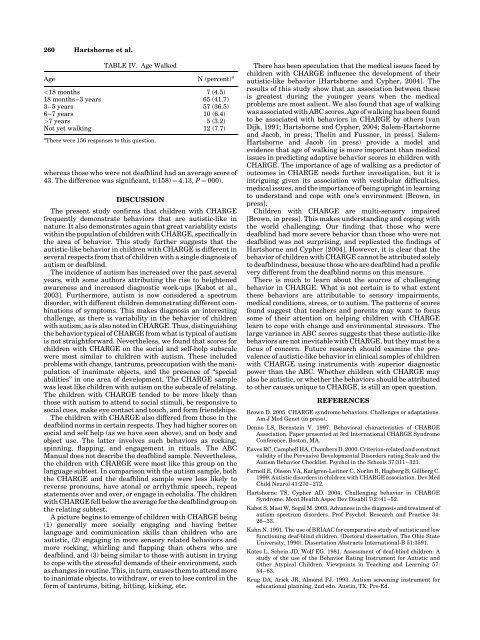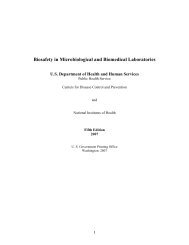Autistic-like behavior in CHARGE syndrome - Central Michigan ...
Autistic-like behavior in CHARGE syndrome - Central Michigan ...
Autistic-like behavior in CHARGE syndrome - Central Michigan ...
You also want an ePaper? Increase the reach of your titles
YUMPU automatically turns print PDFs into web optimized ePapers that Google loves.
260 Hartshorne et al.<br />
TABLE IV. Age Walked<br />
Age N (percent) a<br />
7 years 5 (3.2)<br />
Not yet walk<strong>in</strong>g 12 (7.7)<br />
a There were 156 responses to this question.<br />
whereas those who were not deafbl<strong>in</strong>d had an average score of<br />
43. The difference was significant, t(158) ¼ 4.13, P ¼ 000).<br />
DISCUSSION<br />
The present study confirms that children with <strong>CHARGE</strong><br />
frequently demonstrate <strong>behavior</strong>s that are autistic-<strong>like</strong> <strong>in</strong><br />
nature. It also demonstrates aga<strong>in</strong> that great variability exists<br />
with<strong>in</strong> the population of children with <strong>CHARGE</strong>, specifically <strong>in</strong><br />
the area of <strong>behavior</strong>. This study further suggests that the<br />
autistic-<strong>like</strong> <strong>behavior</strong> <strong>in</strong> children with <strong>CHARGE</strong> is different <strong>in</strong><br />
several respects from that of children with a s<strong>in</strong>gle diagnosis of<br />
autism or deafbl<strong>in</strong>d.<br />
The <strong>in</strong>cidence of autism has <strong>in</strong>creased over the past several<br />
years, with some authors attribut<strong>in</strong>g the rise to heightened<br />
awareness and <strong>in</strong>creased diagnostic work-ups [Kabot et al.,<br />
2003]. Furthermore, autism is now considered a spectrum<br />
disorder, with different children demonstrat<strong>in</strong>g different comb<strong>in</strong>ations<br />
of symptoms. This makes diagnosis an <strong>in</strong>terest<strong>in</strong>g<br />
challenge, as there is variability <strong>in</strong> the <strong>behavior</strong> of children<br />
with autism, as is also noted <strong>in</strong> <strong>CHARGE</strong>. Thus, dist<strong>in</strong>guish<strong>in</strong>g<br />
the <strong>behavior</strong> typical of <strong>CHARGE</strong> from what is typical of autism<br />
is not straightforward. Nevertheless, we found that scores for<br />
children with <strong>CHARGE</strong> on the social and self-help subscale<br />
were most similar to children with autism. These <strong>in</strong>cluded<br />
problems with change, tantrums, preoccupation with the manipulation<br />
of <strong>in</strong>animate objects, and the presence of ‘‘special<br />
abilities’’ <strong>in</strong> one area of development. The <strong>CHARGE</strong> sample<br />
was least <strong>like</strong> children with autism on the subscale of relat<strong>in</strong>g.<br />
The children with <strong>CHARGE</strong> tended to be more <strong>like</strong>ly than<br />
those with autism to attend to social stimuli, be responsive to<br />
social cues, make eye contact and touch, and form friendships.<br />
The children with <strong>CHARGE</strong> also differed from those <strong>in</strong> the<br />
deafbl<strong>in</strong>d norms <strong>in</strong> certa<strong>in</strong> respects. They had higher scores on<br />
social and self help (as we have seen above), and on body and<br />
object use. The latter <strong>in</strong>volves such <strong>behavior</strong>s as rock<strong>in</strong>g,<br />
sp<strong>in</strong>n<strong>in</strong>g, flapp<strong>in</strong>g, and engagement <strong>in</strong> rituals. The ABC<br />
Manual does not describe the deafbl<strong>in</strong>d sample. Nevertheless,<br />
the children with <strong>CHARGE</strong> were most <strong>like</strong> this group on the<br />
language subtest. In comparison with the autism sample, both<br />
the <strong>CHARGE</strong> and the deafbl<strong>in</strong>d sample were less <strong>like</strong>ly to<br />
reverse pronouns, have atonal or arrhythmic speech, repeat<br />
statements over and over, or engage <strong>in</strong> echolalia. The children<br />
with <strong>CHARGE</strong> fell below the average for the deafbl<strong>in</strong>d group on<br />
the relat<strong>in</strong>g subtest.<br />
A picture beg<strong>in</strong>s to emerge of children with <strong>CHARGE</strong> be<strong>in</strong>g<br />
(1) generally more socially engag<strong>in</strong>g and hav<strong>in</strong>g better<br />
language and communication skills than children who are<br />
autistic, (2) engag<strong>in</strong>g <strong>in</strong> more sensory related <strong>behavior</strong>s and<br />
more rock<strong>in</strong>g, whirl<strong>in</strong>g and flapp<strong>in</strong>g than others who are<br />
deafbl<strong>in</strong>d, and (3) be<strong>in</strong>g similar to those with autism <strong>in</strong> try<strong>in</strong>g<br />
to cope with the stressful demands of their environment, such<br />
as changes <strong>in</strong> rout<strong>in</strong>e. This, <strong>in</strong> turn, causes them to attend more<br />
to <strong>in</strong>animate objects, to withdraw, or even to lose control <strong>in</strong> the<br />
form of tantrums, bit<strong>in</strong>g, hitt<strong>in</strong>g, kick<strong>in</strong>g, etc.<br />
There has been speculation that the medical issues faced by<br />
children with <strong>CHARGE</strong> <strong>in</strong>fluence the development of their<br />
autistic-<strong>like</strong> <strong>behavior</strong> [Hartshorne and Cypher, 2004]. The<br />
results of this study show that an association between these<br />
is greatest dur<strong>in</strong>g the younger years when the medical<br />
problems are most salient. We also found that age of walk<strong>in</strong>g<br />
was associated with ABC scores. Age of walk<strong>in</strong>g has been found<br />
to be associated with <strong>behavior</strong>s <strong>in</strong> <strong>CHARGE</strong> by others [van<br />
Dijk, 1991; Hartshorne and Cypher, 2004; Salem-Hartshorne<br />
and Jacob, <strong>in</strong> press; Thel<strong>in</strong> and Fussner, <strong>in</strong> press]. Salem-<br />
Hartshorne and Jacob (<strong>in</strong> press) provide a model and<br />
evidence that age of walk<strong>in</strong>g is more important than medical<br />
issues <strong>in</strong> predict<strong>in</strong>g adaptive <strong>behavior</strong> scores <strong>in</strong> children with<br />
<strong>CHARGE</strong>. The importance of age of walk<strong>in</strong>g as a predictor of<br />
outcomes <strong>in</strong> <strong>CHARGE</strong> needs further <strong>in</strong>vestigation, but it is<br />
<strong>in</strong>trigu<strong>in</strong>g given its association with vestibular difficulties,<br />
medical issues, and the importance of be<strong>in</strong>g upright <strong>in</strong> learn<strong>in</strong>g<br />
to understand and cope with one’s environment [Brown, <strong>in</strong><br />
press].<br />
Children with <strong>CHARGE</strong> are multi-sensory impaired<br />
[Brown, <strong>in</strong> press]. This makes understand<strong>in</strong>g and cop<strong>in</strong>g with<br />
the world challeng<strong>in</strong>g. Our f<strong>in</strong>d<strong>in</strong>g that those who were<br />
deafbl<strong>in</strong>d had more severe <strong>behavior</strong> than those who were not<br />
deafbl<strong>in</strong>d was not surpris<strong>in</strong>g, and replicated the f<strong>in</strong>d<strong>in</strong>gs of<br />
Hartshorne and Cypher [2004]. However, it is clear that the<br />
<strong>behavior</strong> of children with <strong>CHARGE</strong> cannot be attributed solely<br />
to deafbl<strong>in</strong>dness, because those who are deafbl<strong>in</strong>d had a profile<br />
very different from the deafbl<strong>in</strong>d norms on this measure.<br />
There is much to learn about the sources of challeng<strong>in</strong>g<br />
<strong>behavior</strong> <strong>in</strong> <strong>CHARGE</strong>. What is not certa<strong>in</strong> is to what extent<br />
these <strong>behavior</strong>s are attributable to sensory impairments,<br />
medical conditions, stress, or to autism. The patterns of scores<br />
found suggest that teachers and parents may want to focus<br />
some of their attention on help<strong>in</strong>g children with <strong>CHARGE</strong><br />
learn to cope with change and environmental stressors. The<br />
large variance <strong>in</strong> ABC scores suggests that these autistic-<strong>like</strong><br />
<strong>behavior</strong>s are not <strong>in</strong>evitable with <strong>CHARGE</strong>, but they must be a<br />
focus of concern. Future research should exam<strong>in</strong>e the prevalence<br />
of autistic-<strong>like</strong> <strong>behavior</strong> <strong>in</strong> cl<strong>in</strong>ical samples of children<br />
with <strong>CHARGE</strong> us<strong>in</strong>g <strong>in</strong>struments with superior diagnostic<br />
power than the ABC. Whether children with <strong>CHARGE</strong> may<br />
also be autistic, or whether the <strong>behavior</strong>s should be attributed<br />
to other causes unique to <strong>CHARGE</strong>, is still an open question.<br />
REFERENCES<br />
Brown D. 2005. <strong>CHARGE</strong> <strong>syndrome</strong> <strong>behavior</strong>s: Challenges or adaptations.<br />
Am J Med Genet (<strong>in</strong> press).<br />
Denno LS, Bernste<strong>in</strong> V. 1997. Behavioral characteristics of <strong>CHARGE</strong><br />
Association. Paper presented at 3rd International <strong>CHARGE</strong> Syndrome<br />
Conference, Boston, MA.<br />
Eaves RC, Campbell HA, Chambers D. 2000. Criterion-related and construct<br />
validity of the Pervasive Developmental Disorders rat<strong>in</strong>g Scale and the<br />
Autism Behavior Checklist. Psychol <strong>in</strong> the Schools 37:311–321.<br />
Fernell E, Olsson VA, Karlgren-Leitner C, Norl<strong>in</strong> B, Hagberg B, Gillberg C.<br />
1999. <strong>Autistic</strong> disorders <strong>in</strong> children with <strong>CHARGE</strong> association. Dev Med<br />
Child Neurol 41:270–272.<br />
Hartshorne TS, Cypher AD. 2004. Challeng<strong>in</strong>g <strong>behavior</strong> <strong>in</strong> <strong>CHARGE</strong><br />
Syndrome. Ment Health Aspec Dev Disabil 7(2):41–52.<br />
Kabot S, Masi W, Segal M. 2003. Advances <strong>in</strong> the diagnosis and treatment of<br />
autism spectrum disorders. Prof Psychol: Research and Practice 34:<br />
26–33.<br />
Kahn N. 1991. The use of BRIAAC for comparative study of autistic and low<br />
function<strong>in</strong>g deaf-bl<strong>in</strong>d children. (Doctoral dissertation, The Ohio State<br />
University, 1990). Dissertation Abstracts International-B 51:3591.<br />
Kates L, Sche<strong>in</strong> JD, Wolf EG. 1981. Assessment of deaf-bl<strong>in</strong>d children: A<br />
study of the use of the Behavior Rat<strong>in</strong>g Instrument for <strong>Autistic</strong> and<br />
Other Atypical Children. Viewpo<strong>in</strong>ts <strong>in</strong> Teach<strong>in</strong>g and Learn<strong>in</strong>g 57:<br />
54–63.<br />
Krug DA, Arick JR, Almond PJ. 1993. Autism screen<strong>in</strong>g <strong>in</strong>strument for<br />
educational plann<strong>in</strong>g, 2nd edn. Aust<strong>in</strong>, TX: Pro-Ed.
















